
Spring flowers at Postberg Nature Reserve
One of our outings during mom-in-law’s recent visit to Cape Town took us a little bit up the West Coast towards the Langebaan Lagoon. We had last been in this area a couple of months ago, at the height of the spring flower season, when we had gone to see the breathtakingly beautiful fields of flowers in the Postberg Reserve section of the West Coast National Park.
This time, though, we turned off the R27 shortly before the Yzerfontein intersection, at a place called the !Khwa Ttu San Culture and Education Centre. I had seen their large signboard each time we had driven along the R27, and, my curiosity piqued, had done some internet browsing to find out more about this intriguing place:
“!Khwa ttu is based on the theme “A celebration of the San culture, present and past, for a better future”. Its mission statement includes as primary objectives to restore the heritage of the San, to educate the general public about the world of the San and to provide training to the San in various areas.”
You can read more about the background behind this place here, and learn about the history of the farm and the creation of !Khwa ttu – and the tremendous work that went into it – here:
“The land that we now know as ‘!Khwa ttu’ was purchased in 1999. It was then registered under the name of Grootwater, a wheat and sheep producing farm consisting of a number of rather dilapidated farm buildings. The land covers over 850ha and is located in the vicinity of the Atlantic village of Yzerfontein. This is an area not commonly associated with the presence of the San, yet the region’s history reveals that this was once part of the vast territory inhabited for centuries by hunter-gatherers who were brutally persecuted by Boer commandos in the late 18th Century. In honour of our ancestors, the project was named ‘!Khwa ttu’, the term for ‘water-hole’ in the language of the now extinct |Xam San.“
Visitors to !Khwa ttu (the exclamation mark at the start of the word !Khwa is intentional – it indicates a particular kind of click sound made in the mouth) are introduced to the world of the San (Bushmen) – the descendants of the first indigenous people of southern Africa – by means of a San guided tour, described as follows on the website:
“This fascinating insight into the culture, heritage, knowledge and modern-day life of the San of southern Africa entails accompanying a group of our qualified San guides, who will lead you through a truly exceptional experience.
During a one and a half-hour tour the San will demonstrate their skills, share their ancient knowledge about oral history, tracking animals and identifying plants with you. They will also teach you words in some of their languages and enlighten you about recent achievements in obtaining their rights to land and intellectual property. The San-guided experience provides a unique opportunity for you to listen to accurate accounts of the past and present lives of the San.”

The landscape at !Khwa ttu with the dark blue Atlantic ocean in the distance, and a bontebok in the foreground (click to enlarge!)
The tour consists of:
- A tractor ride
- An easy walk on the trail
- A visit to a replica traditional San village
- An introduction on the San languages
- A refreshing drink at the boma
- An exhibition at the photo gallery
When we went on our tour, it only included the first three items on the list, and I’m not entirely sure why this was. Perhaps it was because they were running a holiday special to accommodate more groups?
The tractor ridewas lovely – a little bumpy in places, but our careful driver navigated sharp corners and narrow bridges with impressive skill. We saw some bontebok and, in the far distance, some zebra, their stripey coats camouflaging them really well in the shadow-light of the low shrubs. Suddenly, our tractor-and-trailer came to a stop on the hillside. We clambered down, and followed our two guides into the veld.

He points out differences between front and rear hooves, and the prints made when standing still, walking, or trotting
Our first stop was an open patch of ground onto which our guide splashed some water from a bottle. Intrigued, we huddled closer, as he used a flat piece of wood to smooth out the ground. He picked up a mould from a wooden tray, and used it to create an impression in the damp sand. Ah! It was the hoofprint of a small antelope!

An experienced tracker can learn much from the dung of animals - what they eat, how they digest their food, how recently they have passed through an area...
One by one, he showed us the different tracks made by various animals at !Khwa ttu, explaining that an experienced tracker could see whether the animal had stopped or whether it was running away from a hunter or a predator; there were also subtle differences between the front and back hooves.
A little further along the track, our guide showed us different types of dung – ranging from hard pellets that were impossible to break apart, to very soft flakey dung. Antelopes are ruminants: these are
“hoofed, even-toed, usually horned mammals of the suborder Ruminantia, such as cattle, sheep, goats, deer, and giraffes, characteristically having a stomach divided into four compartments and chewing a cud consisting of regurgitated, partially digested food.”
Antelope droppings tend to be cylindrical or spherical in shape, and are often quite solid pellets.
Interestingly, the steenbok is the one antelope that buries its droppings and urine; with its front hooves, it creates a small depression in the ground, in which the droppings are buried and covered up. It conceals these latrine sites throughout its territory, whereas other antelope regularly use the same locations (A Field Guide to the Tracks and Signs of Southern and East African Wildlife by Chris and Tilde Stuart).
Our guide also demonstrated how a snare is set, using a springy branch and a taut piece of string whose one end is looped on the ground, held in place by means of several wooden pegs. One peg is used as the ‘trigger’, which would tighten the noose around the animal’s neck. I think this would be used for small birds or rabbits.

Ostrich eggs are a treasure: not only do they contain as much yolk as about 24 chicken eggs, but they make perfect water bottles
As you can imagine, in a hot and dry desert environment as found in the Karoo and the Kalahari and in the deserts of Namibia and Botswana, all of which are areas across which the various Bushman groups roamed, water is a particularly precious resource. The shells of large ostrich eggs were often used as water bottles, because they are surprisingly strong while also being quite light to carry. A single ostrich egg contains as much yolk and eggwhite as 24 normal chicken’s eggs, so they were much prized, because they could feed a large group of people.
Once an ostrich egg has been emptied out, and filled with water, it could be buried in the ground, in the shade of bushes, which would keep the water cool. These ‘fridges’ were distributed all over the tribe’s range, to ensure that there was water available for emergencies too. The women would often engrave patterns or other markings into the outer shells, which would allow the owner of the ‘water bottle’ to recognise it as his own.

The milky sap produced by this euphorbia (melkbos) is very poisonous - don't eat it or get it near your eyes!
Our guide explained that the large bush next to which we were standing was a melkbos (or euphorbia). The milky sap produced when a twiglet is broken is very poisonous; he warned us not to attempt to taste it, or to get it near our eyes!
The tips of arrows can be dipped into this sap, which makes them even more effective in killing prey. He explained that, when an animal was shot with an arrow whose tip contained poison, the meat around the wound would be discarded, as it could not be eaten.
Our walking route took us past a large boulder, on which red figures had been painted, depicting a hunting scene. Our guide told us that this rock painting had been done a couple of years earlier. Throughout Southern Africa, there is a wealth of rock engravings and paintings dating back thousands of years; many have been catalogued and are protected, but unfortunately many have also been vandalised and damaged over the years. There is usually (always?) a spiritual or healing component to the creation of these works of art, and they record important events in their lives.
Shortly thereafter, we arrived at a replica San village that had been erected on the hillside, with the huts arranged in a circle around a circular central area, with tree stumps serving as seats. The huts seemed to be made of thatching reed, tied together with wire, I think.
All around the outside of the huts was a makeshift fence, with the gaps between the fence posts filled in with dry thorny branches; these would keep out any large animals or predators. The sand inside this enclosure or kraal would be kept clear of bushes and swept, so that the tracks of any animals, such as snakes, for instance, could be seen immediately. The guide also told us that Bushmen slept with one ear open and alert to the sounds of nature around them – with so little separating them from dangerous predators, they needed to be alert and ready to react immediately to protect themselves and the group.
On one side of the kraal was an opening in the fence, leading to the place where the men would be preparing their weapons for hunting, such as dipping their arrow tips into poisons. Women were prohibited from going there, for the simple practical reason that they were tasked with cooking the food – so it was safer for them not to handle any poisons, in case they contaminated the food. There was an elevated wooden platform there too, with the skulls and horns of dead animals laid ontop. I can’t remember exactly what this was for.
A large bundle was fetched from one of the huts, and spread out in the centre of the circle. It contained all kinds of items, which the San used in their daily lives. These included a water container, hunting weapons (a bow, quiver and arrow), clothing (such as strap-on sandals and loin-cloths), a knife (in the form of a sharp-edged stone) and firesticks.
The arrows consist of two pieces, a metal part at the front and a thin stick at the back, which are slotted together. Our guide explained that, during the hunt, the hunter who owns or has made the arrow that kills the animal is allowed first choice of which part of the animal he would like. The quivers containing the arrow are made of some sort of root that is first soaked, so that the inside becomes soft and easy to scoop out, and then allowed to dry and harden.
Using two young boys as volunteers, they demonstrated how the loin cloths are worn, and how the sandals are strapped on; apparently, it is only the women who wear such sandals.
The women also make beautiful jewellery from ostrich egg shells and other shells. They break the shell into small pieces, which are then rubbed against stones to smooth their edges and to make them vaguely round. A small hole is drilled into the centre of the bead with a hand-drill or awl, which is very time-intensive and fiddly work. The beads are strung into a necklace or bracelet, using whatever natural colours are available to make interesting patterns.
Our guides then demonstrated the use of the firesticks in lighting a fire. Before a young man is allowed to get married, he must be able to light a fire. Our guide did his best to create a flame, by rubbing the tip of one slightly harder stick into a small notch in another slightly softer stick; although we did all catch a whiff of smoke eventually, there was no flame.
Richard decided to give it a try – and also managed to get a bit of smoke, but no flame. It looked like hard work! We have it so easy nowadays – all it takes is a box of matches and some rolled-up newspaper, and if that doesn’t get the wood burning, some magical Blitz firelighters!
Our visit to the village over, we returned to our tractor, and headed home. Back at the base, we thanked our guides, and strolled across to the building with the photo gallery. The current exhibition – titled “Once Upon A Time… Is Now” was fascinating, and is easily worth exploring for a couple of hours. There may also be a guide available to walk visitors through the photographic exhibition, but we just went on our own.
The mantis is an important animal for the San - and the excellent gallery exhibition with audio visual display is definitely worth an extended visit!
“In hunter-gatherer societies stories are vital for sharing and storing knowledge, beliefs and memories. Today San stories are an important part of Bushman heritage shared by communities in South Africa, Namibia and Botswana. They contain useful information about the environment and proper human behavior.
The exhibition gives special attention to two important animals from the Bushman universe: the Mantis and the Eland. In many stories, these animals become characters of special importance dealing with issues of life and death, creation, fertility and magic.”
I also found a very positive review of it here with some lovely photographs:
“The first impression is of a spare, pale space, elegantly empty – and then surprisingly full. It takes time and quiet to absorb the impact. There is a lot to read and a lot to contemplate.” (Review on Kalahari Peoples Network)
It was such a hot day, though, and we were feeling rather tired from being out in the sun so much, that we only lingered for a little while, before the temptations of getting something to eat or drink became too great. Fortunately, there is an excellent coffee shop and restaurant (offering some unusual local dishes), but on this day, the restaurant was very full, with two very large pre-booked groups having reserved tables. The extremely friendly staff helpfully organised a table and some chairs for us in the welcome shade of the patio – out of the direct sun – and we had some cool refreshments before making our way to the arts and craft shop. There are some beautiful items for sale:
“All of our arts and crafts are genuinely produced by the San themselves; from people living in villages based within the remotest parts of Southern Africa.”
“!Khwa ttu offers the San craftsmen of Southern Africa an attractive outlet for their products. Some of the most beautiful pieces which you can find at the crafts shop are made from ostrich eggshells. For hundred of years the San have produced ostrich eggshell jewellery using only simple hand tools. This is an extremely slow and laborious process which requires a great deal of skill. In our shop you can purchase the most up-to-date designs as well as traditional pieces; such as stunning necklaces, bracelets, wraps and bags. We also offer San paintings, bow and arrows, wooden carvings and many more items.”
I’d been wanting to buy an ostrich eggshell necklace for a long time, but was reluctant to buy it from a typical curio shop geared towards tourists, because one doesn’t know whether it is genuinely made by local artists and from local materials, or mass-produced in China from some sort of plastic, and imported! So I was delighted to find a beautiful necklace here – choosing one from the many exquisitely handcrafted items on offer was very difficult!
I also found a marvellous book, titled //Kara’s Rocks (again, the // at the start of the word is intentional, indicating a particularly type of click sound) by local author Lynn Greenwood Smith (you can find a brief review here), which took me only a couple of days to read because it was so rivetting!
If you feel like staying overnight at !Khwa ttu, there is accommodation available, ranging from a 3-bedroom guest house, to a rustic and romantic 2-bedroom bush cottage, and a tented bush camp for those who yearn for an even closer-to-nature experience. We weren’t staying overnight, though I’m quite tempted to do so if I have an opportunity in the future to explore this interesting place some more! They also have conference facilities and arrange special functions.
I am so glad we visited this place!

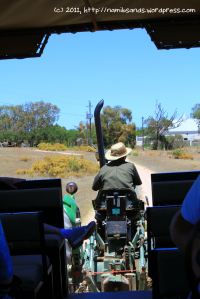
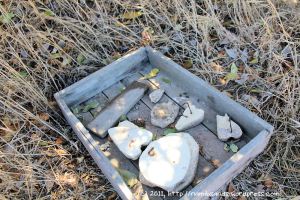



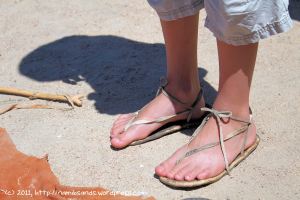
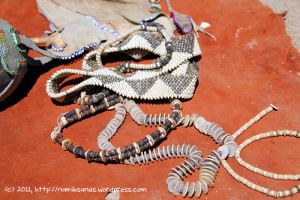

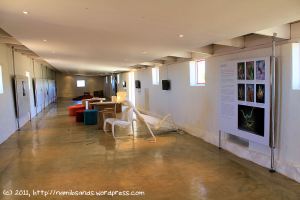





This looks like a great thing to do. I (and most of the world) only know abut the bushmen from The Gods Must Be Crazy I and II.
They came out of those films well enough, but of course we can guess there is a lot more to their culture than that.
Their culture is a lot richer and more complex than we know; our tour only scratched the surface. What struck me most was how close they lived to nature, and how well they used what they found. When they hunt and kill an animal, such as an eland, it is more than just a supply of food for the group; there is a spiritual component too, between the hunter and the prey. And they don’t waste anything – all the parts of the animal are used in some way. In our society, we throw away so much, all the time, unthinkingly, so I found that really impressive. We can learn so much from their knowledge and understanding of the natural world.
I think it’s great that the cultural traditions are being kept alive, and also that they have an educational centre where the rest of us can appreciate them.
You certainly did a lot of interesting things over the Christmas holidays! Thanks for sharing all the outings. I’m pretty much stuck indoors during the summer, and it’s been lovely to travel through your blog.
It was indeed a very interesting place. I hope we’ll visit it again.
Yes, we had quite a full agenda! We didn’t finish all the things on our To Do List, but there’s always the next visit to look forward to.
I’m sorry to hear you’ve been stuck indoors so much, particularly as Riekie came to visit you. I saw on your blog that you hadn’t been feeling all that well. I hope the weather becomes a bit more Lisa-friendly soon!
Exciting and educational tour – to another of the numerous amazing places in South Africa. I look forward to experience some of them myself once …….. 😉
Hi Truels – oh, you definitely should put this on your list of ‘things to do and places to visit’ when you come to South Africa. It is very different to Denmark here though, but you will love it!
What an interesting post. You write so well and your photos are so good I feel as if I were there too. Yet another place I must visit next time I happen to be in CT.
Yes! 😀
Actually, I am working on separate page listing things to do and places to visit in Cape Town and the Western Cape, but the thing just keeps growing and growing, and so it’s not finished yet.